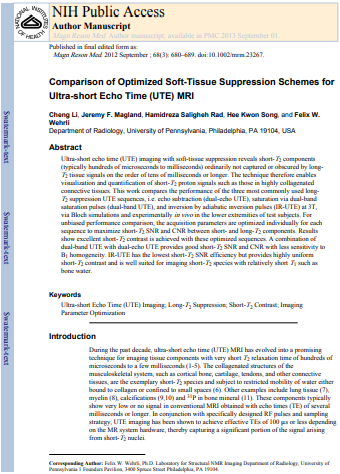Comparison of Optimized Soft-Tissue Suppression Schemes for Creating Short-T2 Contrast with Ultra-Short Echo Time MRI
Abstract
Ultra-short echo time (UTE) imaging with soft-tissue suppression reveals short-T2 components (typically hundreds of microseconds to milliseconds) ordinarily not captured or obscured by longT2 tissue signals on the order of tens of milliseconds or longer. The technique therefore enables visualization and quantification of short-T2 proton signals such as those in highly collagenated connective tissues. This work compares the performance of the three most commonly used longT2 suppression UTE sequences, i.e. echo subtraction (dual-echo UTE), saturation via dual-band saturation pulses (dual-band UTE), and inversion by adiabatic inversion pulses (IR-UTE) at 3T, via Bloch simulations and experimentally in vivo in the lower extremities of test subjects. For unbiased performance comparison, the acquisition parameters are optimized individually for each sequence to maximize short-T2 SNR and CNR between short- and long-T2 components. Results show excellent short-T2 contrast is achieved with these optimized sequences. A combination of dual-band UTE with dual-echo UTE provides good short-T2 SNR and CNR with less sensitivity to B1 homogeneity. IR-UTE has the lowest short-T2 SNR efficiency but provides highly uniform short-T2 contrast and is well suited for imaging short-T2 species with relatively short T1 such as bone water.

